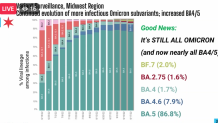A new COVID-19 variant growing in numbers as the BA.5 omicron subvariant begins to decline is one of several variants currently being tracked by the Centers for Disease Control and Prevention heading into fall and winter, as experts watch for a mutation that could cause yet another surge in the pandemic.
While the omicron subvariant BA.5 has been the dominant strain of COVID in the United States for several months, there are at least four other subvariants starting to gain ground in recent weeks.
According to the latest estimates released by the CDC on Tuesday, the BA.5 subvariant is still responsible for 84.8% of COVID cases in the United States. In the Midwest, it's slightly higher, making up 86.8% of cases.
That subvariant, which has been the dominant strain of COVID in the U.S. since early July, peaked at nearly 90% of cases at one point, but has slowly begun to decline as at least four other types of omicron begin to circulate in the population.
Feeling out of the loop? We'll catch you up on the Chicago news you need to know. Sign up for the weekly Chicago Catch-Up newsletter here.
One of those strains, the BA.4.6 subvariant, is now responsible for more than 10% of COVID cases in the United States for the first time. The subvariant, which has been circulating since at least early June, now makes up 10.3% of cases, and is slowly beginning to gain steam as its parent strain BA.4 continues to decline. In the Midwest, BA.4.6 makes up 7.9% of cases.
The BA.4 subvariant is still the third-most common in the U.S., responsible for an estimated 1.8% of cases, but two other subvariants are now being tracked by the CDC as they keep a wary eye on the development of new strains ahead of the fall and winter months.
The BF.7 subvariant is actually a sublineage of BA.5, according to the CDC. Its official name is BA.5.2.1.7, but scientists have instead shortened it to BF.7 in reporting documents.
News
Scientists are continuing to keep a close eye on that subvariant, responsible for 1.7% of cases, because it has now surpassed another sublineage of omicron, BA.2.75, in terms of cases at this time. In the Midwest, BF.7 makes up an even larger percentage of cases, currently sitting at 2%.
According to Fortune magazine, Belgium is currently seeing a surge in BF.7 cases, as are Denmark, Germany and France.
"This BF.7, it's the the first time we're calling this out," Chicago Department of Public Health Commissioner said during a Facebook Live Tuesday, acknowledging the shift in variant tracking. "It's just 2% of the cases... It's an offshoot of BA.5, but it's got another mutation in it, you know, in the spike [protein]."

Scientists are keeping an eye on whether the BF.7 subvariant behaves any differently than BA.5, but all omicron strains have shared similar characteristics, showing increased ability to maneuver around preexisting immunity from earlier infections and an increased ability to avoid immunity conveyed by vaccines.
"BA.5 [is] still most of the cases. Usually we see that one come kind of come out-compete and a new one come in. It's a little unusual to see this BA.2.75 growing again after it had shrunk and the BF.7 - we're watching," Arwady said.
It is not known at this time how effective the new bivalent COVID vaccines, which were specifically formulated to target omicron subvariants, will be against BF.7. Arwady said the new booster shots remain important for increasing protection against the omicron variant and subsequent variants heading into fall and winter.
"One of the reasons we're really excited about this updated COVID vaccine is because, different than for the last year or so, we're back to having a match," Arwady said Tuesday. "So this updated vaccine - kind of like at the beginning those first vaccines were highly protective, we weren't seeing a lot of breakthrough... now again, while it is a good match, I would expect there to be significantly more protection against infection as well."
Until now, COVID-19 vaccines have targeted the original coronavirus strain, even as wildly different mutants emerged. The new U.S. boosters are combination, or “bivalent,” shots. They contain half that original vaccine recipe and half protection against the newest omicron versions, called BA.4 and BA.5, that are considered the most contagious yet.
The combination aims to increase cross-protection against multiple variants.
The move by the FDA tweaks the recipe of shots made by Pfizer and rival Moderna that already have saved millions of lives. The hope is that the modified boosters will blunt yet another winter surge.
"We are back right now to a 99% match between what we are seeing spread and the protection that the vaccine can give," Arwady said. "And my worry is we're going to miss the window. People aren't going to choose to get that updated booster and we will miss the opportunity on an individual level, but more importantly on the societal level to be in the best possible shape heading into winter. I don't know whether we're going to see a new variant emerge in the way omicron did last year. I certainly hope not, but the more people can be matched to what is circulating now, the protection will be better."
Here's a list of variants currently being tracked by the CDC and how prevalent they are in the U.S. or Midwest:
Omicron Subvariants
BA.5 - US: 84.8%, Midwest: 86.8%
BA.4 - US: 1.8%, Midwest: 1.7%
BA.4.6- US: 10.3%, Midwest: 7.9%
BA.2.75 - US: 1.3%, Midwest: 1.6%
BF.7 - US: 1.7%, Midwest: 2%
BA.2.12.1 - 0%
BA.2 - 0%
BA.1.1.529 - 0%
BA.1.1 - 0%
Delta
BA.1.617.12 - 0%



